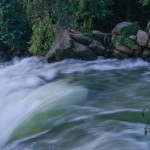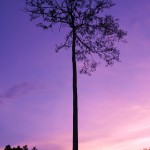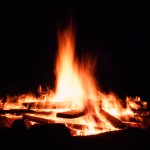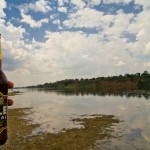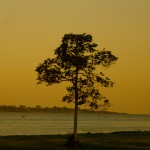Riding the Nile
 The Nile has 2 tributaries – the White Nile and the Blue Nile. The Blue Nile originates at Lake Tara in Ethiopia. The source of the White Nile has not yet been located but is believed to be hidden in the mountains of Uganda and Burundi. We managed to catch up with this legendary river at Jinja in Uganda.
The Nile has 2 tributaries – the White Nile and the Blue Nile. The Blue Nile originates at Lake Tara in Ethiopia. The source of the White Nile has not yet been located but is believed to be hidden in the mountains of Uganda and Burundi. We managed to catch up with this legendary river at Jinja in Uganda.
Landing at Kampala airport, our guide, Herbert declared that out 120km journey to the Jinja camp would take us 3.5 hours by (mud) road. With 7 people packed into Herbert’s car, we were pretty cozy. 2 bottles of wine and a six-pack of beer later, Herbert began to doubt whether 75 USD was worth the trouble.
Day 1 on the Nile
Breakfast took us to a bar that offered us a breathtaking view of the Nile. Words and pictures will not do that scene justice. Although bungee jumping into the water didn’t seem prudent at the time, in retrospect it does seem like a missed opportunity. And so we prepared to make our journey through – the Donald Duck, Dead Dutchman, hair of the dog, 50-50, Bad Place, the Other Place and the mighty Silverback over the next 2 days. Armed with a paddle, lifejacket, helmet and our trusty raft – we were all set to tame the Nile.
Going into the details of all rapids will bore you since my recollection of most rapids is the same. They all started off with a loud sound of water gushing in the distance that grew louder as we paddled. This effect encouraged us (and this could possibly be only me in some cases) to stop paddling. The loud sound was gradually replaced by a feeling of dread, an ‘I’m too young to die’ emotion and a few butterflies in the stomach. The urge to live was the only reason we followed our guide’s counter-intuitive instructions to paddle as hard as possible. Then came the call to get down. I can only guess that an external observer would’ve seen paddles flying all over the place and 7 people scrambling to get their rear ends as close to the bottom of the boat as possible. We escaped the first few rapids with no casualties and only our hearts beating loud enough to drown (no pun intended) the sound of the flowing water.
Although we survived (and you’ll hear me using this word a lot because that’s what each rapid felt like) a grade 5 rapid and a 13-foot (precise approximation) waterfall, the most memorable rapid of theday would be the last series of rapids. In order to get to ’50-50’, we were required to paddle past ‘The Bad Place’. Sadly, this was not meant to be. We ended up on the border of the two rapids andfound out what clothes in a washing machine must feel like. Nick soon found himself spitting in the face of death if we go by his recollection of the event. Elizabeth met the same fate as Nick at ‘The Other Place’.
It was not without considerable joy that we spotted camp and rowed towards the shore to mark the end of day 1. I must mention that rafting causes food and beer to taste like manna from heaven. We saw out the last bit of daylight by hiking to a rock that overlooked the scariest rapid I have ever seen. It didn’t take stories of fools who dared to make me decide that I would never try something like that. Without electricity and with light fading at 6pm, alcohol seemed like the only viable solution. There’s something about a bonfire (even on a warm summer night) that makes a camping trip even more enjoyable. Sleep came quickly as a well-earned reward.
Day 2 on the Nile
All residual feelings from the previous night were quickly overpowered with a massive breakfast; one of the best I’ve had in Africa – bacon, eggs, hash browns, toast, etc. All this at a place that didn’t have electricity. Reunited with our faithful gear, we put on brave faces as we paddled away from camp.
The first rapid of the day saw my dry streak end. Landing in turbulent water with a raft placed firmly on top of you is not an ideal situation to find yourself in. The lifejacket seemed to have a mind of its own as it pinned me against the bottom of the boat. 5 seconds of intense panicking later, I managed to resurface and our trustworthy guide gave me a hand back into the raft.
Next came the mighty grade 5 Silverback that flipped the raft. Surprise surprise!! Some of our less adventurous crew sat that rapid out and could barely suppress grins claiming that our wipeout would’ve made a killer youtube video. Big wave number one saw the boat show up with 2 occupants missing (yours truly being one of them). The boat then disappeared behind huge wave number 2 and showed up with only our Kiwi guide and his Aussie friend clinging on for dear life. Massive wave number 3 ensured that only an overturned boat resurfaced. The yellow helmets bobbing in the water helped the rescue kayaks round up the scattered herd.
Rattled, we made our way through the next stretch of calm water attempting to digest half the Nile that we’d just drunk. It finally got too hot in the boat and we cooled off by jumping right in and navigating the next rapid on our backs, feet up and butt cheeks clenched. We all survived without incident. The last rapid saw an upstream current meeting a downstream current and this ensured that the boat wasn’t pushed in either direction and was instead just violently tossed up and down. I’m convinced that this would be what a rodeo clown riding a bull must feel like. It was fun! We repeated this 3 times and managed to get stuck on this wave the third time. Throwing a man overboard helped us get unstuck. Next came the body boards where we jumped from the bank and paddled into this wave, attempting to ride it.
That marked the end of the rafting. It felt amazing to sit back in the van, enjoy a beer and recall what we’d been through in the last 2 days. We then drove through a few villages, ducking constantly to avoid tree branches taking violent swings at us through the open van. Children rushed to the passing van, each one of them waving and yelling ‘how are you?’ Despite the horrible roads, it was a great drive since we managed to get a glimpse of the beautiful Ugandan countryside.

